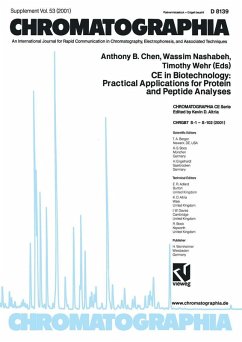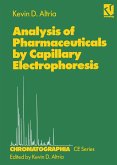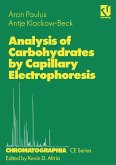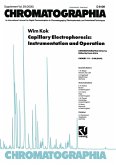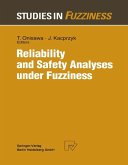CE in Biotechnology: Practical Applications for Protein and Peptide Analyses (eBook, PDF)
Redaktion: Chen, Anthony B.; Wehr, Timothy; Nashabeh, Wassim
40,95 €
40,95 €
inkl. MwSt.
Sofort per Download lieferbar

20 °P sammeln
40,95 €
Als Download kaufen

40,95 €
inkl. MwSt.
Sofort per Download lieferbar

20 °P sammeln
Jetzt verschenken
Alle Infos zum eBook verschenken
40,95 €
inkl. MwSt.
Sofort per Download lieferbar
Alle Infos zum eBook verschenken

20 °P sammeln
CE in Biotechnology: Practical Applications for Protein and Peptide Analyses (eBook, PDF)
Redaktion: Chen, Anthony B.; Wehr, Timothy; Nashabeh, Wassim
- Format: PDF
- Merkliste
- Auf die Merkliste
- Bewerten Bewerten
- Teilen
- Produkt teilen
- Produkterinnerung
- Produkterinnerung

Bitte loggen Sie sich zunächst in Ihr Kundenkonto ein oder registrieren Sie sich bei
bücher.de, um das eBook-Abo tolino select nutzen zu können.
Hier können Sie sich einloggen
Hier können Sie sich einloggen
Sie sind bereits eingeloggt. Klicken Sie auf 2. tolino select Abo, um fortzufahren.

Bitte loggen Sie sich zunächst in Ihr Kundenkonto ein oder registrieren Sie sich bei bücher.de, um das eBook-Abo tolino select nutzen zu können.
In diesem Buch werden neuere Entwicklung in der Analysis von industriell genutzten Proteinen beschrieben. Der Schwerpunkt liegt auf der praktischen Anwendungen der Kapillarelektrophorese in allen Bereichen der Biotechnologie und Pharmazie, von der Formulierung der Rezeptur über Prozessentwicklung, Produkt-Charakterisierung bis hin zu Fragen der Qualitätssicherung.
- Geräte: PC
- ohne Kopierschutz
- eBook Hilfe
- Größe: 18.01MB
Andere Kunden interessierten sich auch für
![Analysis of Pharmaceuticals by Capillary Electrophoresis (eBook, PDF) Analysis of Pharmaceuticals by Capillary Electrophoresis (eBook, PDF)]() Kevin D. AltriaAnalysis of Pharmaceuticals by Capillary Electrophoresis (eBook, PDF)72,95 €
Kevin D. AltriaAnalysis of Pharmaceuticals by Capillary Electrophoresis (eBook, PDF)72,95 €![Analysis of Carbohydrates by Capillary Electrophoresis (eBook, PDF) Analysis of Carbohydrates by Capillary Electrophoresis (eBook, PDF)]() Aran PaulusAnalysis of Carbohydrates by Capillary Electrophoresis (eBook, PDF)40,95 €
Aran PaulusAnalysis of Carbohydrates by Capillary Electrophoresis (eBook, PDF)40,95 €![Capillary Electrophoresis: Instrumentation and Operation (eBook, PDF) Capillary Electrophoresis: Instrumentation and Operation (eBook, PDF)]() Wim KokCapillary Electrophoresis: Instrumentation and Operation (eBook, PDF)40,95 €
Wim KokCapillary Electrophoresis: Instrumentation and Operation (eBook, PDF)40,95 €![The Separation of Enantiomers by Capillary Electrophoresis (eBook, PDF) The Separation of Enantiomers by Capillary Electrophoresis (eBook, PDF)]() Stephen WrenThe Separation of Enantiomers by Capillary Electrophoresis (eBook, PDF)40,95 €
Stephen WrenThe Separation of Enantiomers by Capillary Electrophoresis (eBook, PDF)40,95 €![Reliability and Safety Analyses under Fuzziness (eBook, PDF) Reliability and Safety Analyses under Fuzziness (eBook, PDF)]() Reliability and Safety Analyses under Fuzziness (eBook, PDF)112,95 €
Reliability and Safety Analyses under Fuzziness (eBook, PDF)112,95 €![Inverse Analyses with Model Reduction (eBook, PDF) Inverse Analyses with Model Reduction (eBook, PDF)]() Vladimir BuljakInverse Analyses with Model Reduction (eBook, PDF)72,95 €
Vladimir BuljakInverse Analyses with Model Reduction (eBook, PDF)72,95 €![Boundary Integral Equation Analyses of Singular, Potential, and Biharmonic Problems (eBook, PDF) Boundary Integral Equation Analyses of Singular, Potential, and Biharmonic Problems (eBook, PDF)]() D. B. InghamBoundary Integral Equation Analyses of Singular, Potential, and Biharmonic Problems (eBook, PDF)72,95 €
D. B. InghamBoundary Integral Equation Analyses of Singular, Potential, and Biharmonic Problems (eBook, PDF)72,95 €-
-
-
In diesem Buch werden neuere Entwicklung in der Analysis von industriell genutzten Proteinen beschrieben. Der Schwerpunkt liegt auf der praktischen Anwendungen der Kapillarelektrophorese in allen Bereichen der Biotechnologie und Pharmazie, von der Formulierung der Rezeptur über Prozessentwicklung, Produkt-Charakterisierung bis hin zu Fragen der Qualitätssicherung.
Dieser Download kann aus rechtlichen Gründen nur mit Rechnungsadresse in A, B, BG, CY, CZ, D, DK, EW, E, FIN, F, GR, HR, H, IRL, I, LT, L, LR, M, NL, PL, P, R, S, SLO, SK ausgeliefert werden.
Produktdetails
- Produktdetails
- Verlag: Vieweg+Teubner Verlag
- Seitenzahl: 102
- Erscheinungstermin: 17. April 2013
- Englisch
- ISBN-13: 9783322830210
- Artikelnr.: 53316302
- Verlag: Vieweg+Teubner Verlag
- Seitenzahl: 102
- Erscheinungstermin: 17. April 2013
- Englisch
- ISBN-13: 9783322830210
- Artikelnr.: 53316302
- Herstellerkennzeichnung Die Herstellerinformationen sind derzeit nicht verfügbar.
Anthony B. Chen, Ph.D. has worked for over fifteen years at Genentech Inc. South San Francisco, CA developing analytical assays for recombinant protein pharmaceuticals. He introduced the use of novel analytical applications, including CE, for routine protein analyses in the Quality Control department. Wassim Nashabeh, Ph.D. has worked with CE for over ten years, including pre- and postdoctoral studies and CE for commercial applications. He is Associate Director, Quality Control, Genentech Inc. where he has validated several CE methods used in the lot release of marketed protein therapeutics. Timothy Wehr, Ph.D. developed CE instrumentation and application kits as manager of the CE chemistry R&D group at Bio-Rad laboratories, Richmond, CA and has developed CE methods for biopharmaceuticals at Bay Bioanalytical Laboratory, Richmond CA.
1 Capillary Electrophoresis in the Development of Recombinant Protein Biopharmaceuticals.- 1.1 Summary.- 1.2 Introduction.- 1.3 Capillary Electrophoresis Reviews.- 1.4 Reviews of CE Used for the Analysis of Recombinant Proteins.- 1.5 Recent CE Literature.- 1.6 Quality Control and Validation.- 1.7 Developments in CE-MS.- 1.8 References.- 2 Selection of Buffers in Capillary Zone Electrophoresis: Application to Peptide and Protein Analysis.- 2.1 Introduction.- 2.2 Buffer Parameters.- 2.3 Buffers Used for the Separation of Peptides and Proteins.- 2.4 Acknowledgements.- 2.5 References.- 3 Reverse-Phase High Performance Liquid Chromatography and Capillary Zone Electrophoresis Separation of Protegrin Analogs.- 3.1 Abstract.- 3.2 Introduction.- 3.3 Experimental.- 3.4 Results and Discussion.- 3.5 References.- 4 Use of Capillary Electrophoresis to Determine the Dilute Protein Concentration in Formulations Containing Interfering Excipients.- 4.1 Abstract.- 4.2 Introduction.- 4.3 Material and Methods.- 4.4 Result and Discussion.- 4.5 Conclusion.- 4.6 Acknowledgements.- 4.7 References.- 5 Effects of the Solution Environment on the Resolution of Recombinant Human Deoxyribonuclease Variants in Capillary Zone Electrophoresis.- 5.1 Abstract.- 5.2 Introduction.- 5.3 Materials.- 5.4 Methods.- 5.5 Results and Discussion.- 5.6 Conclusion.- 5.7 Acknowledgements.- 5.8 References.- 6 Recent Advances in Capillary Isoelectric Focusing.- 6.1 Introduction.- 6.2 Theory and Practice of cIEF.- 6.3 cIEF in Microchannels.- 6.4 Imaging cIEF.- 6.5 cIEF-Mass-Spectrometry.- 6.6 Capillary Isoelectric Focusing of Monoclonal Antibodies.- 6.7 Capillary Isoelectric Focusing of Hemoglobin and Hemoglobin Variants.- 6.8 Capillary Isoelectric Focusing of Erythropoietin.- 6.9 Novel Applications of cIEF.- 6.10 References.- 7 Separation of Enbrel® (rhuTNFR: Fc) Isoforms by Capillary Isoelectric Focusing.- 7.1 Abstract.- 7.2 Introduction.- 7.3 Experimental.- 7.4 Results and Discussion.- 7.5 Acknowledgements.- 7.6 References.- 8 Optimization, Validation, and Use of Capillary Gel Electrophoresis for Quality Control Testing of Synagis®, a Monoclonal Antibody.- 8.1 Abstract.- 8.2 Introduction.- 8.3 Methods.- 8.4 Regulatory Guidance.- 8.5 Optimization Strategy.- 8.6 Validation.- 8.7 Validation Parameters for CGE.- 8.8 Acknowledgements.- 8.9 References.- 9 Analysis of Protein Therapeutics by Capillary Electrophoresis.- 9.1 Introduction.- 9.2 Capillary Electrophoresis - Sodium Dodecylsulfate (CE-SDS).- 9.3 Capillary Isoelectric Focusing (cIEF).- 9.4 Capillary Zone Electrophoresis (CZE).- 9.5 Carbohydrate Analysis.- 9.6 Methods.- 9.7 Acknowledgements.- 9.8 References.- 10 Sensitive and High Resolution CE/MS/MS for Protein Identification in Complex Mixtures.- 10.1 Introduction.- 10.2 Approaches to Improve the Sensitivity of CE/MS/MS for Protein Identification.- 10.3 Approaches to Improve the Resolution of CE/MS/MS for Protein Identification.- 10.4 Other Approaches.- 10.5 Conclusions.- 10.6 References.- Abbreviations.
1 Capillary Electrophoresis in the Development of Recombinant Protein Biopharmaceuticals.- 1.1 Summary.- 1.2 Introduction.- 1.3 Capillary Electrophoresis Reviews.- 1.4 Reviews of CE Used for the Analysis of Recombinant Proteins.- 1.5 Recent CE Literature.- 1.6 Quality Control and Validation.- 1.7 Developments in CE-MS.- 1.8 References.- 2 Selection of Buffers in Capillary Zone Electrophoresis: Application to Peptide and Protein Analysis.- 2.1 Introduction.- 2.2 Buffer Parameters.- 2.3 Buffers Used for the Separation of Peptides and Proteins.- 2.4 Acknowledgements.- 2.5 References.- 3 Reverse-Phase High Performance Liquid Chromatography and Capillary Zone Electrophoresis Separation of Protegrin Analogs.- 3.1 Abstract.- 3.2 Introduction.- 3.3 Experimental.- 3.4 Results and Discussion.- 3.5 References.- 4 Use of Capillary Electrophoresis to Determine the Dilute Protein Concentration in Formulations Containing Interfering Excipients.- 4.1 Abstract.- 4.2 Introduction.- 4.3 Material and Methods.- 4.4 Result and Discussion.- 4.5 Conclusion.- 4.6 Acknowledgements.- 4.7 References.- 5 Effects of the Solution Environment on the Resolution of Recombinant Human Deoxyribonuclease Variants in Capillary Zone Electrophoresis.- 5.1 Abstract.- 5.2 Introduction.- 5.3 Materials.- 5.4 Methods.- 5.5 Results and Discussion.- 5.6 Conclusion.- 5.7 Acknowledgements.- 5.8 References.- 6 Recent Advances in Capillary Isoelectric Focusing.- 6.1 Introduction.- 6.2 Theory and Practice of cIEF.- 6.3 cIEF in Microchannels.- 6.4 Imaging cIEF.- 6.5 cIEF-Mass-Spectrometry.- 6.6 Capillary Isoelectric Focusing of Monoclonal Antibodies.- 6.7 Capillary Isoelectric Focusing of Hemoglobin and Hemoglobin Variants.- 6.8 Capillary Isoelectric Focusing of Erythropoietin.- 6.9 Novel Applications of cIEF.- 6.10 References.- 7 Separation of Enbrel® (rhuTNFR: Fc) Isoforms by Capillary Isoelectric Focusing.- 7.1 Abstract.- 7.2 Introduction.- 7.3 Experimental.- 7.4 Results and Discussion.- 7.5 Acknowledgements.- 7.6 References.- 8 Optimization, Validation, and Use of Capillary Gel Electrophoresis for Quality Control Testing of Synagis®, a Monoclonal Antibody.- 8.1 Abstract.- 8.2 Introduction.- 8.3 Methods.- 8.4 Regulatory Guidance.- 8.5 Optimization Strategy.- 8.6 Validation.- 8.7 Validation Parameters for CGE.- 8.8 Acknowledgements.- 8.9 References.- 9 Analysis of Protein Therapeutics by Capillary Electrophoresis.- 9.1 Introduction.- 9.2 Capillary Electrophoresis - Sodium Dodecylsulfate (CE-SDS).- 9.3 Capillary Isoelectric Focusing (cIEF).- 9.4 Capillary Zone Electrophoresis (CZE).- 9.5 Carbohydrate Analysis.- 9.6 Methods.- 9.7 Acknowledgements.- 9.8 References.- 10 Sensitive and High Resolution CE/MS/MS for Protein Identification in Complex Mixtures.- 10.1 Introduction.- 10.2 Approaches to Improve the Sensitivity of CE/MS/MS for Protein Identification.- 10.3 Approaches to Improve the Resolution of CE/MS/MS for Protein Identification.- 10.4 Other Approaches.- 10.5 Conclusions.- 10.6 References.- Abbreviations.
